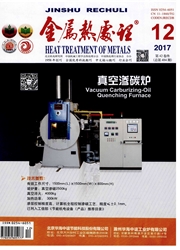

 中文摘要:
中文摘要:
用示差扫描热分析(DSC)、XRD、光学显微镜等方法研究了850℃退火对Ti-50.84at%Ni合金紧箍环显微组织、相变特征和形状恢复率的影响。结果表明,Ti-50.84at%Ni合金锻造态和退火态组织都以Ni-Ti基体母相(B2)为主,而锻造后深冷处理则以Ni-Ti基体马氏体相(B19′)为主,3种状态都含有少量的Ni4Ti3相。850℃退火后,合金中Ni4Ti3相减少且细小弥散,产生了较大的反相变应力,并增加了基体中的Ni含量,使得合金的马氏体转变温度(Ms)明显降低,且与R相变分离。高温退火消除了合金中的位错等缺陷有利于马氏体逆相变的进行,从而提高了紧箍环的形状恢复率和恢复力。
 英文摘要:
英文摘要:
The effect of high temperature annealing treatment at 850 ℃ on microstructure, transformation and shape recovery rate of Ti-50. 84at% Ni shape memory alloy ring was studied by DSC, XRD and optics-microscope. The results show that microstructure of the forged and annealed Ti-50. 84at% Ni alloys is rich in Ni-Ti-parent-phases (B2) ,but the deep-cooled alloy is rich inNi-Ti-martensite( B19′), and all of them have a small quantity of Ni4Ti3. After annealing at 850 ℃, the NinTi3 precipitates become finer and less, which brings high anti-transformation stress and increases Ni content in the matrix. This leads that martensite transformation temperature (Ms)of the alloy is decreased and martensite transformation is separated from R transformation. The high temperature annealing eliminates the high-density dislocation defect in Ti-50. 84at% Ni alloy, which is propitious for martensite reverse-transformation, so it improves the shape recovery rate and restoring force of Ti-50. 84at% Ni alloy ring.
 同期刊论文项目
同期刊论文项目
 同项目期刊论文
同项目期刊论文
 Principle and realization of improving shape memory effect in Fe–Mn–Si–Cr–Ni alloy through aligned p
Principle and realization of improving shape memory effect in Fe–Mn–Si–Cr–Ni alloy through aligned p Influence of ageing after pre-deformation on shape memory effect in a FeMnSiCrNiC alloy with 13 wt.%
Influence of ageing after pre-deformation on shape memory effect in a FeMnSiCrNiC alloy with 13 wt.% Further improvement of shape memory effect in a pre-deformed Fe-Mn-Si-Cr-Ni-Nb-C alloy by smaller Nb
Further improvement of shape memory effect in a pre-deformed Fe-Mn-Si-Cr-Ni-Nb-C alloy by smaller Nb Remarkable improvement of shape memory effect in an Fe–Mn–Si–Cr–Ni–C alloy through controlling preci
Remarkable improvement of shape memory effect in an Fe–Mn–Si–Cr–Ni–C alloy through controlling preci Directional precipitation of carbides induced by γ/ε interfaces in an FeMnSiCrNiC alloy aged after d
Directional precipitation of carbides induced by γ/ε interfaces in an FeMnSiCrNiC alloy aged after d Improvement of shape memory effect in an Fe-Mn-Si-Cr-Ni alloy fabricated by equal channel angular pr
Improvement of shape memory effect in an Fe-Mn-Si-Cr-Ni alloy fabricated by equal channel angular pr Remarkable improvement of recovery stress of Fe–Mn–Si shape memory alloy fabricated by equal channel
Remarkable improvement of recovery stress of Fe–Mn–Si shape memory alloy fabricated by equal channel Influence of initial microstructures on effectiveness of training in a FeMnSiCrNi shape memory alloy
Influence of initial microstructures on effectiveness of training in a FeMnSiCrNi shape memory alloy Improvement of shape memory effect in an Fe–Mn–Si–Cr–Ni–Nb–C alloy by NbC precipitated through agein
Improvement of shape memory effect in an Fe–Mn–Si–Cr–Ni–Nb–C alloy by NbC precipitated through agein 期刊信息
期刊信息
